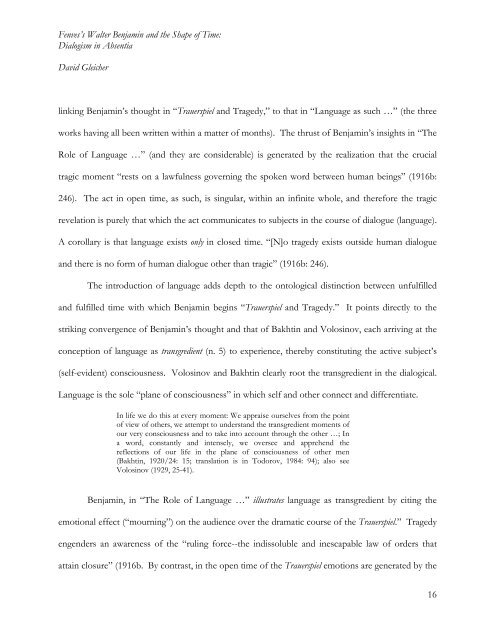Peter Fenves's Walter Benjamin and the Shape ... - Adelphi University
Peter Fenves's Walter Benjamin and the Shape ... - Adelphi University
Peter Fenves's Walter Benjamin and the Shape ... - Adelphi University
You also want an ePaper? Increase the reach of your titles
YUMPU automatically turns print PDFs into web optimized ePapers that Google loves.
Fenves’s <strong>Walter</strong> <strong>Benjamin</strong> <strong>and</strong> <strong>the</strong> <strong>Shape</strong> of Time:<br />
Dialogism in Absentia<br />
David Gleicher<br />
linking <strong>Benjamin</strong>’s thought in “Trauerspiel <strong>and</strong> Tragedy,” to that in “Language as such …” (<strong>the</strong> three<br />
works having all been written within a matter of months). The thrust of <strong>Benjamin</strong>’s insights in “The<br />
Role of Language …” (<strong>and</strong> <strong>the</strong>y are considerable) is generated by <strong>the</strong> realization that <strong>the</strong> crucial<br />
tragic moment “rests on a lawfulness governing <strong>the</strong> spoken word between human beings” (1916b:<br />
246). The act in open time, as such, is singular, within an infinite whole, <strong>and</strong> <strong>the</strong>refore <strong>the</strong> tragic<br />
revelation is purely that which <strong>the</strong> act communicates to subjects in <strong>the</strong> course of dialogue (language).<br />
A corollary is that language exists only in closed time. “[N]o tragedy exists outside human dialogue<br />
<strong>and</strong> <strong>the</strong>re is no form of human dialogue o<strong>the</strong>r than tragic” (1916b: 246).<br />
The introduction of language adds depth to <strong>the</strong> ontological distinction between unfulfilled<br />
<strong>and</strong> fulfilled time with which <strong>Benjamin</strong> begins “Trauerspiel <strong>and</strong> Tragedy.” It points directly to <strong>the</strong><br />
striking convergence of <strong>Benjamin</strong>’s thought <strong>and</strong> that of Bakhtin <strong>and</strong> Volosinov, each arriving at <strong>the</strong><br />
conception of language as transgredient (n. 5) to experience, <strong>the</strong>reby constituting <strong>the</strong> active subject’s<br />
(self-evident) consciousness. Volosinov <strong>and</strong> Bakhtin clearly root <strong>the</strong> transgredient in <strong>the</strong> dialogical.<br />
Language is <strong>the</strong> sole “plane of consciousness” in which self <strong>and</strong> o<strong>the</strong>r connect <strong>and</strong> differentiate.<br />
In life we do this at every moment: We appraise ourselves from <strong>the</strong> point<br />
of view of o<strong>the</strong>rs, we attempt to underst<strong>and</strong> <strong>the</strong> transgredient moments of<br />
our very consciousness <strong>and</strong> to take into account through <strong>the</strong> o<strong>the</strong>r …; In<br />
a word, constantly <strong>and</strong> intensely, we oversee <strong>and</strong> apprehend <strong>the</strong><br />
reflections of our life in <strong>the</strong> plane of consciousness of o<strong>the</strong>r men<br />
(Bakhtin, 1920/24: 15; translation is in Todorov, 1984: 94); also see<br />
Volosinov (1929, 25-41).<br />
<strong>Benjamin</strong>, in “The Role of Language …” illustrates language as transgredient by citing <strong>the</strong><br />
emotional effect (“mourning”) on <strong>the</strong> audience over <strong>the</strong> dramatic course of <strong>the</strong> Trauerspiel.” Tragedy<br />
engenders an awareness of <strong>the</strong> “ruling force--<strong>the</strong> indissoluble <strong>and</strong> inescapable law of orders that<br />
attain closure” (1916b. By contrast, in <strong>the</strong> open time of <strong>the</strong> Trauerspiel emotions are generated by <strong>the</strong><br />
16


